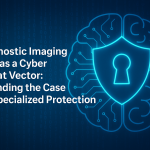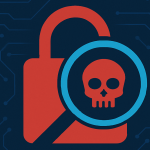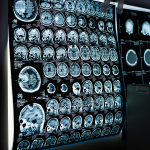Introduction
Digital Imaging and Communications in Medicine (DICOM) is an essential standard for medical imaging in modern healthcare. While DICOM facilitates the storage, exchange, and visualization of medical images, it also introduces security vulnerabilities that could be exploited maliciously. This article explores various security aspects of DICOM files, underscoring the need for robust protective measures.
Understanding DICOM File Structure
DICOM files are complex, integrating image data with extensive metadata that includes patient information, imaging parameters, and other diagnostic data. A significant feature within these files is the 128-byte preamble, designed for compatibility with non-DICOM software. This feature enhances interoperability but introduces vulnerabilities through potential misuse for embedding malicious code.
An Example of Preamble Functionality
- The Preamble and TIFF Header: The preamble, which occupies the first 128 bytes of a DICOM file and is typically set to zero, can be utilized to store the header of another file format like TIFF.
- Location of Image Data: The actual image data associated with the TIFF header is not in the preamble but follows the DICOM data, accessible via offset information in the preamble.
- Dual Functionality: This setup enables the file to be used in both medical imaging (DICOM) and other fields or applications like image viewing software that support or may require the TIFF format, enhancing versatility in fields like pathology or research where high-quality imaging and broad compatibility are required.
Specific Vulnerabilities: CVE-2019-11687 Case Study
One significant security issue, highlighted by CVE-2019-11687 and underscored by both a DHS alert (https://www.securityweek.com/malware-can-be-hidden-dicom-medical-imaging-files-dhs-warns/) and research from Cylera Labs (https://researchcylera.wpcomstaging.com/2019/04/16/pe-dicom-medical-malware/) , involves the DICOM Part 10 File Format’s vulnerability in its preamble. This format, specified by the NEMA DICOM Standard versions from 1995 through 2019b, allows for the embedding of executable file headers, such as Portable Executables (PE) containing malware. This vulnerability enables malware to go undetected within the preamble, posing a stealthy threat often overlooked by standard security measures in healthcare settings.
Broader Security Concerns in DICOM Files
Beyond the preamble, DICOM files face additional security risks:
- Data Hiding: Techniques like steganography can embed additional data or malicious content within the pixel data of DICOM images, eluding standard security checks.
- File Concatenation: External files, such as ZIP archives, can be appended to DICOM files, facilitating the distribution of malware under the guise of legitimate medical files.
- Metadata Manipulation: Malicious modifications to metadata fields can serve as a vector for attacks, allowing unauthorized actions or data breaches.
Mitigation Strategies for Advanced Threats
To combat the outlined threats, several mitigation strategies are essential:
- In-depth Content Inspection: Systems must thoroughly analyze all file components, including metadata and pixel data.
- Behavioral Analysis: Monitoring how files behave upon access can detect abnormal actions, providing early warnings of potential misuse.
- Encryption and Access Controls: Strong encryption and stringent access controls are critical for protecting data integrity and confidentiality.
- Regular Audits and Compliance Checks: Ensuring adherence to data protection standards through regular audits is crucial for maintaining security.
SecureDICOM from WetStone Labs: Enhancing Security in Medical Imaging
SecureDICOM by WetStone Labs is an essential component of a layered security framework for protecting medical imaging data within healthcare systems. It provides essential capabilities for both initial inspections and ongoing security assessments of DICOM files.
Integration with Security Strategies
- Initial Content Inspection at Data Entry: SecureDICOM initiates its protective measures at the very point DICOM files enter the healthcare IT systems. It performs an in-depth inspection to detect potential threats or anomalies in the files. This initial scrutiny helps to intercept and address security issues before the files are integrated into the broader system, stored, or processed further.
- Continuous Security Monitoring: After the initial inspection, SecureDICOM engages in ongoing surveillance of DICOM files as they are accessed, modified, or transferred within the healthcare IT ecosystem. This continuous monitoring is essential for detecting any signs of malicious manipulation that could lead to malware spread or data breaches. By identifying these threats in real-time, SecureDICOM enables immediate and effective responses to mitigate potential security risks.
- Proactive Scanning: In addition to real-time monitoring, SecureDICOM supports scheduled and on-demand deep scans of systems where DICOM files are stored, such as Picture Archiving and Communication System (PACS) servers. These scans are designed to occur at regular intervals, ensuring consistent surveillance and maintenance of security standards. Additionally, on-demand scanning capabilities allow for immediate responses to specific incidents or concerns, offering flexibility to adapt to emerging threats. This two-pronged approach of scheduled and responsive scans is crucial for uncovering latent threats that may not be detected by real-time monitoring, thereby providing a robust additional layer of security.
- Synergy with Other Security Measures: SecureDICOM is part of a holistic security strategy and works in tandem with an organization’s other security tools, including behavioral analysis, encryption technologies, and access control systems. This multi-faceted approach enhances data security during transmission and storage, strengthening overall cybersecurity defenses. By integrating SecureDICOM’s comprehensive inspections with both dynamic and static security measures, the organization not only upholds stringent privacy and compliance standards but also enhances operational integrity and resilience against cyber threats. This strategy is essential for protecting sensitive medical data and ensuring the reliable operation of healthcare facilities.
Conclusion
With the increasing reliance on digital technologies within the healthcare sector, ensuring the security of medical imaging files is becoming increasingly critical. The identified vulnerabilities, such as the exploitable preamble in the DICOM file format, data hiding, file concatenation, and metadata manipulation, represent some of the significant risks that need to be addressed through comprehensive security strategies.
SecureDICOM from WetStone Labs, along with other security measures, plays a vital role in safeguarding these medical imaging systems. Through initial content inspections, continuous security monitoring, proactive scanning, and integration into the existing security infrastructure of an organization, SecureDICOM ensures that DICOM files are protected not only at the point of entry but throughout their lifecycle within healthcare IT systems. The combination of these strategies helps in preventing malware spread, unauthorized data access, and potential data breaches, thus maintaining the integrity and confidentiality of sensitive medical data.






